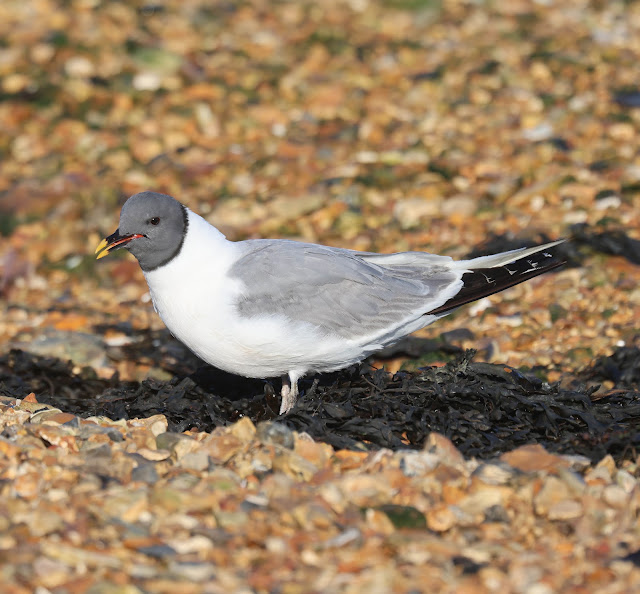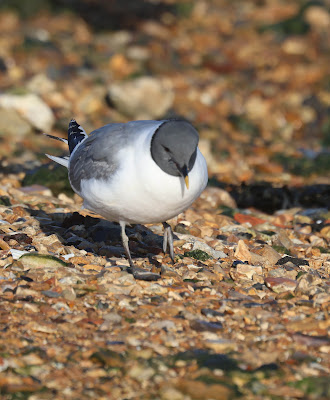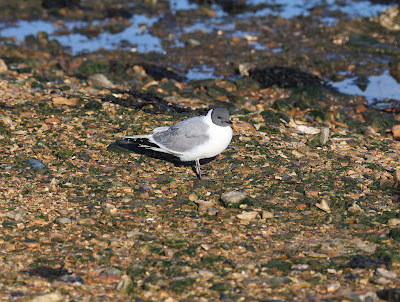 |
| A young kite in its second year of life. Note the oveall duller plumage and pale fringes to the wing coverts.It will mout into adult plumage at the end of this year and breed in its third year of life |
Tuesday, 24 January 2023
Red Kites 23rd January 2023
Thursday, 19 January 2023
Sabs Revisited 19th January 2023
I had also arranged to meet two other birding colleagues, Mark and Les here. There had been no news on whether the gull was present as myself and Peter drove south from Oxfordshire and we were still none the wiser on getting to the small car park by the seawall at Langstone Harbour. However the number of birders milling around told us that surely the gull was still here and immediately on getting out of the car the Sabine's Gull conveniently flew past us and along the seawall before settling on a pebble beach virtually below us.
A female stonechat perched on a post just in from the seawall, her plumage turned to ginger in the strong sunlight while a Little Egret was a shock of white as it waded in the blue waters of the marshland beyond.
The Sabine's Gull flew from the beach and we followed it southwards along the seawall to the area of saltmarsh and lagoons that it most favoured. Mid morning and the tide was full but on the ebb. Far out on the shining waters of the harbour were four Black necked Grebes, a Great Northern Diver and a diving Long tailed Duck. On the receding tideline Grey Plovers and Curlews called evocatively, their melancholic voices ringing out in the still air, a vocal prompt of the wilder summer homes they will seek when winter departs. Smaller waders were on the move too, stirring as the shore became exposed. Turnstones and Dunlins mainly, flying at speed in tight groups across the silver waters with no time to lose in these short hours of feeding opportunity.
The Sabs meanwhile, regularly flew back and fore along the seawall, dipping down to the sea to snatch a morsel, sometimes passing over the heads of unsuspecting arriving birders on the seawall, while we positioned ourselves by the saltmarsh to wait, as we knew for certain it would return here.
There is little more to say except that we sat or stood in the sun for the next four hours watching the gull on the shingle before us or intermittently flying around, charming us with its beauty and charismatic presence
Here are some more images that I took today of the Sabine's Gull.
Tuesday, 17 January 2023
The South Coast Sabines 15th January 2023
I have seen a good number of Sabine's Gulls over the years, the majority in juvenile plumage so one in adult summer plumage, in winter and showing exceptionally well, inevitably proved impossible to resist.
On Friday the 13th I set off early to make the two hour drive to Budd's Farm and all went well until half way along the M27 and just a few miles to the turn off for my destination the four lanes of heavy traffic came to a halt nose to tail and there we remained for the best part of an hour. The police had closed the motorway due to a fatal accident earlier and as usual the resulting traffic chaos was left to sort itself out. It was hopeless with cars jammed on all the other surrounding roads as they sought a way round the closure and in the end I gave up and drove back home, there to renew my acquaintance with the wintering Yellow browed Warbler at Donnington in Oxford. It was hardly a consolation.
The Sabs continued to be reported throughout Saturday and I resolved to make another attempt to see it on Sunday the 15th, leaving home at 5.30am, knowing the day was going to be sunny but very windy. This time there was no motorway incident to impede my southward progress and eventually I passed through a large shopping complex, then turned down Southmoor Lane and as instructed drove to the far end and found myself in a small car park by the seawall.
Even at 8am on a Sunday there was no lack of birders, virtually all intent on seeing the Sabine's Gull which has rapidly attained celebrity status due to its obliging nature, overall attractiveness and easy accessibility. Not sure where to go a helpful departing birder told me to head left along the seawall as the gull was loafing on an area of brackish salt marsh that contained a shallow lagoon rather than at the sewage outfall which was off to the right.
On taking the track along the seawall I received the full force of a strong southwest wind blowing directly in from the huge harbour. Dark bellied Brent Geese, immune to the elements were feeding out by the edge of the sea while Oystercatchers and Common Redshanks examined the rocks and pools being exposed by the falling tide.
A brisk walk for a quarter of a mile got me to the lagoon and saltmarsh, an area called Southmoor where the sea has breached the seawall, creating some very nice habitat.
I could see about a dozen birder's stood out on the mud looking at a small white gull sat on an island of green weed and mud just beyond and opposite them. A look through my bins was all that was needed to confirm it was the Sabine's Gull.
Joining the group I stood and waited to see what the currently squatting gull would do. The answer was not a lot as it continued to sit whilst being visibly buffeted by the wind it was facing into. It was not the only one being inconvenienced by a wind continually coming at some force from the harbour, passing over the seawall and battering at my back in vicious gusts. Thankfully well insulated I was mostly immune to the wind chill and with the sun at my back was all set for some camera action.
There were twenty or so Black headed Gulls flying into the wind and every so often dipping down to the lagoon to delicately pick a morsel from its surface. Reaching the far end of the lagoon they would turn and be swept downwind only to bank at the other end and repeat their performance.The Sabs seemed little interested in joining this activity but eventually roused itself, flew into the wind and promptly disappeared towards the sewage outfall. After the wait and growing anticipation this came as something of a disappointment to put it mildly.
With the star attraction now absent I turned my attention to the lagoon, searching for any other birdlife to bump up this year's birdlist. Two Common Greenshanks were a pleasant surprise, their pale plumage a razzle dazzle of white courtesy of the bright sunshine while a female Goosander, that went to sleep on a distant mudbank, was equally unexpected. Apart from this there were just the usual Common Redshanks and a small group of Dark-bellied Brent Geese.
Fifteen minutes later the Sabs was back, looking noticeably small and tern like as it flew amongst the feeding Black headed Gulls, the latter keeping a respectful distance from us birders clustered on a bank of shingle. Not so the Sabs which flew past us and then turned into the wind and came very close before dropping to the surface and gobbling a scrap of fish, which I was to learn had been distributed by one or two of my fellow birders .
It came extraordinarily close at times, no more than twenty feet away, standing on patches of mud and weed in the shallow water and gobbling up the fish scraps. It was so near at times I was forced to reduce the zoom on my lens but I was hardly going to complain about having such a beautiful gull so close to me.
Of course, as is now customary, virtually everyone present had a camera and many of my fellow birders prostrated themselves on the gravel and mud to get that eye level shot. Maybe it's a macho thing, the coating of mud and grime serving as a badge of honour.
Rather them than me as they would do just as well by crouching or kneeling and save themselves the bother but each to their own.
Most small gull species are remarkably beautiful in breeding plumage and the Sabs was no exception, even more so in the early morning light. Its head was hooded and depending on the angle at which it was held appeared either charcoal grey or darker with a distinct black collar bordering where the hood joined the white feathers of its nape and neck. Its black bill was generously tipped with sulphur yellow, while its slender body was the standard gull combo of medium grey above and white below. When it flew however, it revealed a startling wing pattern of contrasting triangles of black, white and grey with predominantly black on the outer primaries, white on the inners and secondaries and grey wing coverts. The tail was markedly forked and all white.
Looking at my images of this bird it would appear that the feathers were very worn. Noticeably the white spots on each of its primaries were much abraded as were the tips of the primaries and its tail was similarly worn and ragged.The upper body feather tracts also showed wear. So was this an adult that aberrantly had not moulted out of its summer plumage? Due to the obvious feather wear it surely had not prematurely moulted into summer plumage.
Sabine's Gulls have a circumpolar breeding distribution ranging from Alaska and the Canadian Arctic to Greenland, and Spitzbergen to the Taimyr Peninsula in Russia. Most North American Sabines spend the winter in the Pacific Ocean off South America while populations from Greenland and eastern Canada cross southwards in the middle of the Atlantic Ocean to winter in the Benguela Current off southwest Africa. There is also conjecture, due to the number of inland records, that some birds from North America, Europe and even Siberia may move overland to their winter homes at sea. Many are also driven east in gales and storms to fetch up on the coasts of Ireland and Britain.This may well be responsible for the arrival of this individual I went to see on Sunday. Presumably caught up in an Atlantic storm it had been blown northeast by gales and like many another of its kind made landfall on the coast of Britain. Could the gale that enveloped it have resulted in the retension of its worn plumage? Unlikely but possible, the bird concentrating on survival and putting any moult on hold.
It seemed happy enough in its temporary albeit alien environment and why not as Southern Water are disgracefully continuing to pump industrial quantities of raw sewage into the sea off the southern counties of Britain, including Langstone Harbour, as the hundreds of gulls around the sewage outflow nearby made all too obvious.I could not help but reflect that the juxtaposition of a beautiful and romantic gull feeding on gallons of discharged human excrement acted as an allegory for our human world and the way we continually abuse it
For the first hour the gull was continually on show, either making brief sorties over the lagoon to pick up morsels of fish or to stand on one of the many mini islands of exposed weed, braving the wind by using its wings to balance. Opportunities were so numerous to watch and admire it at close quarters one almost became blase, almost but not quite as this was virtually a unique event and therefore to be savoured.
After several forays to the sewage outfall it settled to its original resting place on the little island of mud and weed as meanwhile a continual procession of birders arrived to admire it whilst others departed to explore further areas of the harbour.
For over an hour it remained immobile, squatting on the weed and mud, only its head moving constantly, looking this way and that. It was attritional standing in the buffeting and cold wind as we all waited for it to do something, anything but it resolutely refused to play ball. Obviously stuffed full with fish bits donated by various birders it was not even tempted when yet more fish scraps were cast upon the water.
Finally it stood up and now we felt was the opportunity for the flight shots we had all been waiting for and anticipating but no, it flew steadily into the wind to the far end of the lagoon, cleared the trees there and headed for the sewage outfall once more. Cue a mass departure of birders and toggers. I joined them as frankly it was a joy to move my limbs and regain some warmth.
I went back to my car for a quiet sit and scan of my photos. It was a relief to leave the wind outside and when sufficiently revived in body and spirit I did not want to leave and succumbed to the lure of more Sabs adoration. Well who wouldn't? Walking back to the lagoon I found the gull had returned to its little sanctuary of mud and weed and was, as per usual doing very little.I hung on until it made a move and as before it headed off to the sewage outfall but unusually it was back in just a few minutes and settled once more on its island.
One more image of it sat on its favourite spot and I decided that four hours of admiring the Sabs at close quarters had done both it and myself justice.

























.jpg)















.jpg)
.jpg)






.jpg)



















